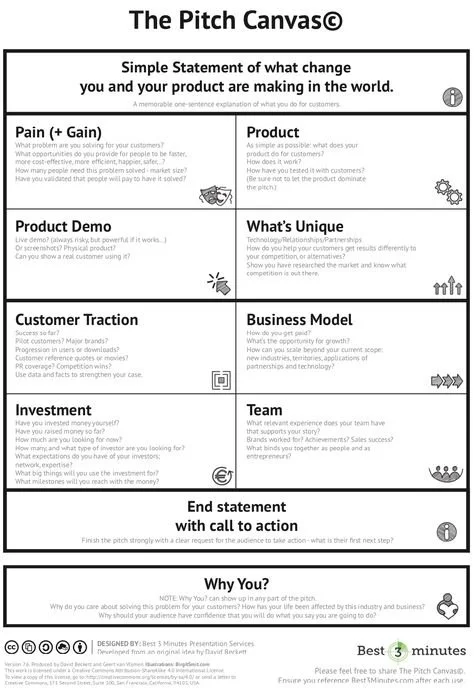Building The First Draft Of Your Pitch
“According to most studies, people's number-one fear is public speaking. Number two is death. Death is number two! Now, this means to the average person, if you have to go to a funeral, you're better off in the casket than doing the eulogy.” – Jerry Seinfeld
You are going to get the chance to talk about yourself and your work
These moments are gifts, but they come with pressure.
If you make the most of them, they can lead to work, money, introductions and new paths you hadn’t seen.
These moments also come with the risk of feeling silly, under-qualified and unworthy
Some people have natural talent for public speaking, but there are lots of ways to pitch, and most of them are learnable skills.
Today we’ll look at the principles behind good pitches, some of the common formats you’ll encounter, and explore some tricks for telling a compelling story
Principles For Pitching
Before we look at structures or slides, we should establish the fundamental ideas and mindsets behind pitching.
Pitching is in your interest, but if you’ve resolved not to do it, no tricks or techniques will make you comfortable or convincing.
These principles and approaches might make the process easier:
You are not your business, you are introducing your business
It’s not your life story, and it doesn’t need to be adjusted to suit your own narrative or identity.
In the same way that you’re more likely to talk up your friend than to talk up yourself, you’re allowed to make a compelling introduction to the business without it being seen as self-indulgent.The three rules of public speaking:
Be interesting, be interesting, be interesting.
Interesting is more important than comprehensive or lucrative.
If the audience has tuned out, all of your work will go to waste.It’s your job to find what’s interesting.
As Matt Mullenweg said “Everyone is interesting. If you're ever bored in a conversation, the problem’s with you, not with the other person.”
If you can’t articulate that interesting story, it’s your job to go digging for the real message for your presentation.
The material is there, you just haven’t put in the work yet.People only know what you show them - for better and for worse
You’ve forgotten how much you know about your work, and a pitch is only ever going to be a tiny glimpse into the complexity, history and future of your company.
You get to stage-manage that tiny glimpse, hiding the details you want to disguise, and accentuating the parts that you want people to remember.
You have control over the story, but a responsibility to give context and a catchup for anyone who is unfamiliar with your brand.
People do business with people, and with people they know, like and trust.
While we said this pitch is about the business and not you, you are the main person people will associate with the company, so you have an important role to play.
The audience needs to feel that they know who you are, they need to like you as a person, and they need to trust that you can do what you say you will do.
These three concepts (know, like, trust) will shape many of the smaller decision you make when designing your presentation.Do you want a compliment or a conversation?
"When Aeschines spoke, they said, ‘How well he speaks.’ But when Demosthenes spoke, they said, ‘Let us march against Philip.’" - David Ogilvy
A pitch for a business is not a public speaking contest, and so the aim is not to earn a compliment for your stage presence.
The aim is to prompt an action, like starting a conversation, asking a question, making a referral or setting up another meeting.
Your job is to think about the action you want the audience to take, and use that as the metric for how well the pitch is going.If the audience can’t summarize your pitch for their mum, it isn’t a good pitch
Your mum is likely a smart person – even if she doesn’t work in your industry or speak in your coded language.
For this reason, a good pitch should be able to be summarised/relayed to a smart outsider, perhaps missing some of the specific details, but with the right overall message.
If the audience can’t summarise what you’ve said, it means you either lost them, overwhelmed them or misled them.Get some story assets to do the heavy lifting
You don’t need to take responsibility for conveying the whole message yourself, good businesses have assets that help tell, enhance and extend your stories.
This might be through your visual templates, testimonials, photos, video clips, social media posts, handouts, brochures and collateral, etc.
When done well, these add a lot of professionalism and credibility to your claims, paint a clearer picture of your company, and appeal to any audience who aren’t as swayed by verbal presentations.Feel free to override the “rules”, but probably break one rule at a time
Your job is to understand what usually works and why it works, so that you know when it’s advantageous to do the opposite.
Tell stories back to front, lead with unusual details, be deliberately “unprofessional” in some aspect, bring in a new technology.
But maybe don’t be all of these at once – too much novelty overshadows your message.
Elements of every pitch
Your presentations will adapt to suit different scenarios – an elevator pitch is different to a boardroom presentation.
Sometimes you’re talking to a fellow industry veteran, sometimes you’re talking to friends of friends at a barbeque.
No matter what, you’ll feel confident and can improvise if you know how to convey each of these elements:
Who you are – your name and your brand
Although it feels more dramatic to start with a story or bold statistic, people are unlikely to ask you questions if they can’t remember your name or your company’s name.
This is why it’s worth choosing a name that doesn’t embarrass you when you say it out loud.Problem you’ve identified
You probably started this business for a reason – a friend had an issue, you had a need and couldn’t find something you liked so you made your own scrappy solution, there was a gap in the market, a technological change created a headache, a certain part of the market was being ignored or excluded, etc.
This is your chance to give context on your industry, your work to date, and a sense of why the world needs your startup to stay in business.Knife turn
A knife turn is a few short sentences that can turn a good pitch into a great pitch.
This is when you slowly, painfully and intentionally dwell on the pain of your problem, creating an uncomfortable moment for your audience.
Instead of “current solutions aren’t serving _______, so we created ______”, you focus on the human, emotional and justice of the situation.
That might become “current solutions aren’t serving ________, so they are ______. They struggle to __________ and feel _________, limiting their _______.
That’s why we created _________.”
These might be details that you think are already obvious, but they create powerful moments in your pitch.An uncommon common-sense solution
Once you’ve explained the problem and its consequences, you can introduce your work and your solutions.
The aim here is to avoid being boring or outrageous.
Don’t make it sound like anyone could do the same thing, but also don’t pretend that you’re a rare breed of genius.
Your solution should make the audience say “Oh right, of course!” or “I didn’t know about that, but it makes sense!”.How a customer benefits
Similar to the knife turn, this is your chance to explain how a customer uses your work, what it does for them, how their life/business improves and what that will lead to.
If it boosts their confidence, how will they feel and behave?
If it earns them money, how much and what will that unlock?
If it improves their company, how much and what will that mean?Where you fit in the market
Assuming that your audience are not experts in your field, you’ll need to paint a brief, clear and honest picture of your “competitive set”.
Competitive set refers to the other options that your customers might be choosing between.
i.e. your city might have 600 cafes, but your customers are realistically going to pick from 3-4 that are within a certain geography, certain style, certain speciality or certain price range.
You can show where you fit in relation to your competitors, be it based on price, quality, speciality, credibility, ease of use, etc.
This can be as informal as “we’re similar to _______ but with more _______”.How you make a margin
You don’t need to show people any detailed financials, but they’ll be trying to understand how you make money, where you spend money, and whether or not this sounds like a viable business to be in.
You can talk about different prices and packages, some rule-of-thumb costs, or a sense of what it takes for the business to break even.Traction and validation
Kevin O’Leary from Shark Tank says “No matter what I think, sales will prove me wrong”.
If you have examples of customer interest, successful prototypes, pre-sales, enthusiasm from industry partners, etc, then these add tremendous credibility and excitement to all of your earlier claims.
People like to support businesses that are already popular, so any evidence of appreciation or approval become contagious.
You can draw these from your customer interviews, prototypes, partner conversations, or quotes from any end users.What you’re doing next
While this might feel obvious to you, it won’t be obvious to everyone else – what’s on the horizon?
What’s on in the next month?
Where are you going, what are you testing, what does the next phase of development hold?
There is no strict rule here, but like most things in business, having too much or too little ambition can be off-putting.
Yes it’s good to have big plans and aspirations, but these are hard to interpret for your audience.
If you want a billion dollar valuation, great, but also talk about what you want to achieve along the way, and how quickly you’re making progress.How can someone be involved
A good conversation is a terrible thing to waste, so think about how this person might want to be involved in the next phase of your journey.
That might be by introducing you to a colleague or friend who would love your work, or to follow your brand on social media/email list, or to take the next step in the buying process, to offer guidance or mentorship, or to set up a second conversation to talk in more detail.
Again, if you don’t think the audience are interesting people, the problem lies with you.
Image: best3minutes.com
Using The Pitch Canvas
One of the best single-page tools for brainstorming your next presentation is The Pitch Canvas, originally created by David Beckett at Best3Minutes.
Using this framework, you’ll touch on each of the following for 30-50 seconds each:
1. A simple statement about what you’ve built and why it exists
2. A description of the customer and the pain/gain they want resolved/created
3. An engaging summary of your product and how it works
4. A demonstration, through a prototype, video or case study
5. An explanation of what’s unique or different about this product
6. Stories and evidence of “traction”, how people are already starting to buy from you
7. A summary of your business model, e.g. where you fit in the value chain
8. The investment or support you’re looking for (from the audience)
9. Who’s on your team and why they’re top quality people
10. A closing statement and call to action
11. (BONUS) why you’re the right person, or why you feel called to run this business
For each of the above, the key is to find what’s interesting in your business for each point.
They don’t have to strictly be in that order, and they don’t need equal amounts of time.
You can start with a story if it’s a good one, but otherwise this order helps clear up the audience’s questions in a logical flow.
You don’t have to cover every single box, and you can shuffle around the order, but broadly speaking it makes sense to structure it as:
1. Intro (name, company, short statement)
2. First section (Pain & Gain, Product, Product Demo, What’s Unique, in whatever order makes the most sense).
3. Second section (Customer Traction, Business Model, Investment, Team, in whatever order makes the most sense).
4. Ask and close (End statement, Call To Action)
The canvas leaves you with an initial 5-7 min draft that you can easily improve, and that’s all we need for the time being.
Starting With The 5 Minute Pitch
Five minute pitches are notoriously hard to prepare, making them a good starting point.
Once you have a good 5 minute structure, it’s relatively easy to scale it up or down, whereas it’s hard to trim a 20 minute presentation down to 5 minutes.
Realistically, you’re actually designing two pitches: the introductory 5 mins, and then 10 mins of backup content (case studies, data, answers to the obvious questions)
If you’re worried about memorising a script, you only need to nail the opening and the close, then you have some creative license in the middle.
Your job now is to:
· Find the most interesting parts of your startup and your story
· Use The Pitch Canvas to create a 5-7 minute draft structure
· Practice a few variations of your story, particularly the opening, the knife turn and the close
Next, we’ll look at ways of improving your presentation, as well as designing helpful visuals like slides…




